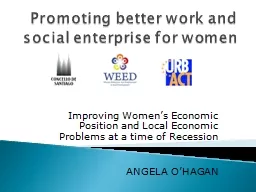PPT-Promoting better work and social enterprise for women
Author : marina-yarberry | Published Date : 2017-01-23
Improving Womens Economic Position and Local Economic Problems at a time of Recession ANGELA OHAGAN The differential impact on women versus men will vary across
Presentation Embed Code
Download Presentation
Download Presentation The PPT/PDF document "Promoting better work and social enterpr..." is the property of its rightful owner. Permission is granted to download and print the materials on this website for personal, non-commercial use only, and to display it on your personal computer provided you do not modify the materials and that you retain all copyright notices contained in the materials. By downloading content from our website, you accept the terms of this agreement.
Promoting better work and social enterprise for women: Transcript
Download Rules Of Document
"Promoting better work and social enterprise for women"The content belongs to its owner. You may download and print it for personal use, without modification, and keep all copyright notices. By downloading, you agree to these terms.
Related Documents














